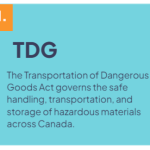Risks of TDG Non-Compliance
Transportation of Dangerous Goods (TDG) regulations are crucial for ensuring the safe handling, transportation, and delivery of hazardous materials. Non-compliance with these regulations can lead to severe consequences, affecting public safety, the environment, and businesses. Understanding the risks associated with TDG non-compliance and the importance of proper training is essential for all stakeholders involved in the transportation of dangerous goods.
Legal Consequences
One of the most significant risks of TDG non-compliance is the potential for legal action. In Canada, violations of TDG regulations can result in substantial fines and even imprisonment. Fines for non-compliance can range from $250 to $100,000, with the possibility of up to five years of imprisonment for serious offenses. These penalties serve as a deterrent and underscore the importance of adhering to TDG regulations.
Financial Impact
Beyond legal penalties, non-compliance can lead to significant financial consequences. Incidents caused by improper handling or transportation of dangerous goods can result in:
– Costly clean-up and disposal fees
– Damage to goods, property, and equipment
– Increased insurance premiums
– Legal fees associated with litigation
These financial burdens can have long-lasting effects on a company’s bottom line and overall financial stability.
Reputational Damage
Non-compliance incidents can severely tarnish a company’s reputation. Negative publicity resulting from accidents or violations can lead to:
– Loss of business and customer trust
– Difficulty attracting new clients
– Challenges in recruiting and retaining employees
In today’s interconnected world, reputational damage can spread quickly and have far-reaching consequences for a business’s long-term viability.
Environmental and Public Safety Risks
Perhaps the most critical aspect of TDG compliance is its role in protecting the environment and public safety. Non-compliance increases the risk of:
– Accidents and spills during transportation
– Release of hazardous materials into the environment
– Contamination of ecosystems
– Potential harm to public health and safety
These risks underscore the importance of strict adherence to TDG regulations to safeguard communities and the environment.
The Role of Training in Mitigating Risks
Proper Training is a cornerstone of TDG compliance and plays a vital role in mitigating the risks associated with the transportation of dangerous goods.
Knowledge and Skills Development
TDG training provides employees with the necessary knowledge and skills to handle dangerous goods safely. This includes:
– Understanding the classification of dangerous goods
– Proper packaging, labelling, and marking procedures
– Documentation requirements
– Emergency response protocols
By equipping workers with this knowledge, training significantly reduces the risk of accidents, injuries, and property damage.
Legal Compliance
TDG training is not just a best practice; it’s a legal requirement. The TDG Act mandates that anyone involved in handling, offering for transport, or transporting dangerous goods must receive appropriate training. Compliance with this requirement helps companies avoid legal penalties and demonstrates a commitment to safety and regulatory adherence.
Risk Awareness and Prevention
Training heightens awareness of potential hazards associated with dangerous goods. This increased awareness enables workers to:
– Identify potential risks in their daily operations
– Implement preventive measures to avoid accidents
– Respond effectively in case of emergencies
This proactive approach to risk management is crucial for maintaining a safe working environment and preventing incidents before they occur.
Continuous Improvement
The field of dangerous goods transportation is dynamic, with regulations and best practices evolving over time. Regular TDG training ensures that workers stay up to date with:
– Changes in regulations
– New safety protocols
– Emerging best practices in the industry
This ongoing education fosters a culture of continuous improvement and adaptation to new safety standards.
Enhanced Decision-Making
Proper training empowers employees to make informed decisions when handling dangerous goods. This improved decision-making capability is crucial for:
– Selecting appropriate packaging
– Ensuring correct labelling and documentation
– Responding effectively to unexpected situations
By enhancing the decision-making skills of workers, training contributes to overall operational efficiency and safety.
Conclusion
The risks associated with TDG non-compliance are substantial, ranging from legal and financial consequences to environmental and public safety hazards. However, comprehensive and ongoing training serves as a powerful tool in mitigating these risks. By investing in proper TDG training, companies not only ensure compliance with regulations but also protect their employees, the public, and the environment. Moreover, training fosters a culture of safety and responsibility that extends beyond mere regulatory compliance, contributing to a safer and more efficient transportation industry for dangerous goods.
Complete our poll on “What is your biggest challenge with TDG compliance” by clicking Take this Quiz button below.








































Preparing Report...
Please wait... we are calculating your results
* Do not leave the page or reload the page *

Classification is a cornerstone of TDG (Transportation of Dangerous Goods) compliance. It involves accurately identifying the nature of your goods and determining their classification according to the TDG Regulations. Many professionals struggle with this because it requires a deep understanding of chemical properties, hazards, and compatibility with regulatory frameworks.
Common Challenges:
- Lack of Expertise: Many individuals find it difficult to interpret technical data sheets (TDS) or safety data sheets (SDS) to extract relevant hazard information.
- Complexity of Regulations: TDG classifications often overlap with other regulatory frameworks like WHMIS and international standards, adding layers of complexity.
- Dynamic Nature of Goods: Changes in product formulations or physical state can affect classification, leading to confusion.
Strengths:
- Having a baseline awareness of hazardous properties is a good start.
- Access to documentation like SDS and regulatory manuals offers a foundation to work from.
Suggestions for Improvement:
- Training: Invest in TDG-specific training focused on classification to build a solid understanding.
- Leverage Tools: Utilize classification software and tools to streamline the process.
- Consult Experts: Engage with consultants or forums to clarify doubts and ensure accuracy.
Call to Action: Join the Regulatory Insights Community at www.markroehler.com/community to access expert resources, share your challenges, and learn from professionals dealing with similar classification issues.

Understanding TDG regulations can be overwhelming, especially for those new to the field or dealing with evolving compliance requirements. These regulations cover everything from packaging to labelling and reporting incidents, making them comprehensive but challenging to navigate.
Common Challenges:
- Regulatory Jargon: Legal and technical language can be a barrier for many.
- Frequent Updates: Changes to the regulations often require ongoing learning and adaptation.
- Interconnected Rules: TDG compliance is often linked to other regulatory frameworks, creating confusion.
Strengths:
- Access to online and printed TDG manuals provides an opportunity to self-educate.
- A willingness to learn is key to overcoming this challenge.
Suggestions for Improvement:
- Break Down Regulations: Focus on understanding one section at a time to avoid overwhelm.
- Interactive Training: Attend workshops, webinars, or interactive courses tailored to TDG regulations.
- Regulatory Updates: Subscribe to regulatory update newsletters to stay informed.
Call to Action: Join the Regulatory Insights Community at www.markroehler.com/community to discuss and clarify regulatory requirements with experienced professionals.

One of the fundamental challenges in TDG compliance is identifying whether your goods qualify as dangerous. Misidentification can lead to non-compliance or over-compliance, both of which have significant consequences.
Common Challenges:
- Conflicting Information: Discrepancies between different regulatory documents or guidelines.
- Lack of Training: Many individuals don’t have formal training in identifying dangerous goods.
- Broad Categories: The wide range of hazardous materials categories can make classification confusing.
Strengths:
- Possessing an SDS or technical data for your products is a solid starting point.
- Having some knowledge of chemical hazards is beneficial.
Suggestions for Improvement:
- Familiarize Yourself: Learn to interpret SDS and understand hazard classes outlined in the TDG Regulations.
- Professional Guidance: Seek advice from regulatory consultants or experienced colleagues.
- Hands-On Training: Participate in training sessions focused on identifying dangerous goods.
Call to Action: Become a member of the Regulatory Insights Community at www.markroehler.com/community to gain access to expert insights, tools, and peer discussions to improve your understanding.

Proper packaging, marking, and labelling are critical components of TDG compliance. Incorrect practices can lead to accidents, fines, or shipment delays.
Common Challenges:
- Complex Requirements: Regulations for packaging, marking, and labelling vary depending on the type and class of goods.
- Resource Limitations: Lack of access to compliant packaging materials or labelling tools.
- Misinterpretation: Confusion about the correct placement and format of labels and markings.
Strengths:
- A basic understanding of TDG symbols and markings is a good foundation.
- Awareness of packaging requirements indicates a proactive approach to compliance.
Suggestions for Improvement:
- Reference Guides: Keep a TDG manual or quick reference guide handy.
- Standard Operating Procedures (SOPs): Create SOPs for packaging and labelling specific to your operations.
- Hands-On Practice: Engage in practical exercises to apply the principles of packaging and labelling.
Call to Action: Join the Regulatory Insights Community at www.markroehler.com/community to access tutorials, resources, and expert advice to enhance your compliance practices.
For additional information on why you should hire an external instructor for providing dangerous goods training, view our FAQ page.













